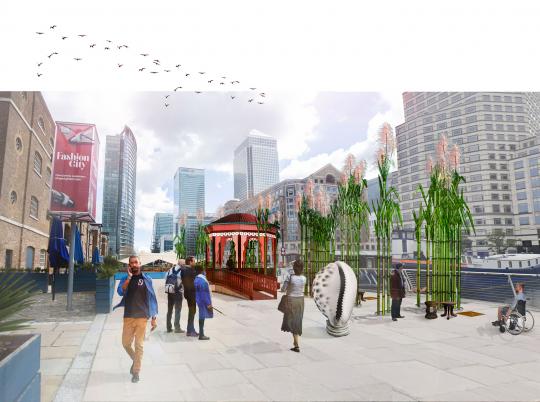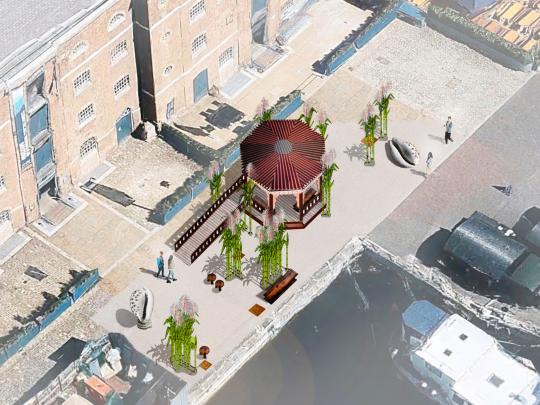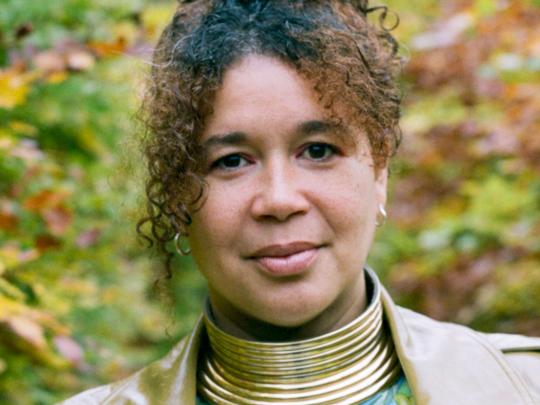Echoes from beneath the deep and in between the canes by Alberta Whittle
“I am Barbadian but my family made their home in London during the 1960s. Family conversations nurtured a commitment to reimagine freedom in the wake of enslavement. In the Americas, the Caribbean and the African continent, proof of transatlantic slavery resides in plantations, barracoons and fields of sugarcane, tobacco, cocoa and coffee. In Britain the evidence has been disguised.”

My proposed artwork, Echoes from beneath the deep and in between the canes brings together visual cues from across the African diaspora. These include a Caribbean-style pavilion and a sculptural representation of a sugarcane field, carved wooden stools and large cowrie shell sculptures. Juxtaposing sugarcane alongside London’s Docklands’ former warehouses will create a strong visual connection with shared histories that echo beyond the Thames and reverberate across the Atlantic.
This is a tactile artwork, designed for people to touch and take pleasure in its textures. It will embed a variety of materials and techniques. We will work with accessibility advisors to ensure that the work considers its audiences and their varied needs – including people with mobility needs, families, the visually impaired, older people and children. Community engagement is central to the evolution of the artwork.

West India Quay is a site of memory and conquest – simultaneously speaking of arrival and departure, goods and people. It speaks of the commodifying of enslaved people. By situating my artwork here, I hope to open a space for people to gather, mourn, reflect and find connection.
Satellite artwork and engagement
My memorial will be heavily informed by community engagement across London. I aim to meet with intergenerational communities to inform the design of the stools and explore the iconography placed upon them. We will also reflect on the potential uses for the pavilion structure.
At the satellite locations I will produce smaller installations consisting of the key elements from West India Quay memorial.
There are significant opportunities for public storytelling events, concerts and workshops to take place at the West India Quays memorial.
I propose to invite performers, musicians and storytellers to bring their responses, testimonies and research to the artwork at key dates, such as International Day for the Elimination of Racial Discrimination, Windrush Day, International Slavery Remembrance Day and more.
I am also interested in including audio works developed through creative workshops. I would make them available to audiences to download and listen to around the installation and at the satellite locations.

Meet the artist: Alberta Whittle

Alberta’s creative practice encompasses drawing, digital collage, film, sculpture, performance and writing. These different media combine to form a visual, oral, and textual language through which Whittle questions accepted Western constructs of history and society. Her public presentations are often choreographed as interactive installations that speak to the site they are being presented. They prioritise themes of self-care and compassion, while considering the historic legacies and contemporary expressions of anti-Blackness, colonialism, and migration. Her work is included in a number of permanent national collections.
Selected recent solo exhibitions include:
- Sargasso Sea (with Dominique White), Institute of Contemporary Art, Philadelphia (2024)
- between a whisper and a cry, Institute of Contemporary Art, Los Angeles (2023)
- create dangerously, Scottish National Gallery of Modern Art, Edinburgh (2023-2024)
- Dipping below a waxing moon, the dance claims us for release, Holburne Museum, Bath (2023)
- deep dive (pause) uncoiling memory, 59th Venice Biennale, Venice (2022)
Selected group exhibitions include:
- Soulscapes, Dulwich Picture Gallery, London (2024)
- Life between islands: Caribbean British Art 1950s – Now, Art Gallery of Ontario, Toronto (2023, touring from Tate, London, 2021)
- Soft and weak like water, 14th Gwangju Biennale, Gwangju (2023)
- Black Melancholia, CCS Bard Hessel Museum of Art, Annandale-on-Hudson (2022)
- Sex Ecologies, Kunsthall Trondheim, Norway (2021)
Images courtesy of the Alberta Whittle and The Modern Institute/Toby Webster Ltd, Glasgow.
Cast your vote for the Memorial commission
Vote for an artistNeed a document on this page in an accessible format?
If you use assistive technology (such as a screen reader) and need a version of a PDF or other document on this page in a more accessible format, please get in touch via our online form and tell us which format you need.
It will also help us if you tell us which assistive technology you use. We’ll consider your request and get back to you in 5 working days.